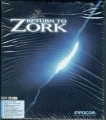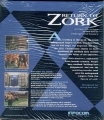Return to Zork
First posted on 29 May 1998. Last updated on 11 August 2009.
Return to Zork is the first game in the Zork series to be set entirely in a graphical world. As such the question that springs immediately to mind is whether or not the essence of the puzzles, dialogs, and humor that is characteristically Zorkian can survive the transfer to a graphical medium. Return to Zork succeeds as well as it can be expected from such a first attempt. While the game is not perfect and has weakness, it remains as a very good game and is a definite must for all Zork and adventure game fans.
The story of Return to Zork takes place farthest into the future of any previous game in the Zork series. The Great Underground Empire of Zork has been supposedly rediscovered, but things are not quite right. People are disappearing as are whole buildings. According to the myth, the Great Underground Empire of Zork is destroyed long in the past and all evil magic has been dispersed. You are now the lucky sweepstakes winner to take a trip to the Great Underground Empire. Before you can actually reach the underground, something goes wrong. You find yourself instead in the Valley of the Sparrows, wondering where to go and what to do next. You begin your journey with only a Zony Recorder, a camera, and a Tele-Orb. Your first job is to find your way into the Great Underground Empire and then find out what has gone wrong.
Considering the time when this title is released, the production of Return of Zork is impressive. To modern gamers the graphics may look a bit pixelated, especially the movie sequences, but they are cutting edge for that time. What this title has started which many successors have since followed is an effort to merge computer graphics with live action sequences. Whereas other games that use entirely live action but end up leaving you with absolutely no control, this game gives you all of the control of a graphical game but with the real life feel and advantage of live acting. As for the actors themselves, they vary from very good to fairly bad. Overall, the acting is still good enough to give a convincing (or at least not detracting) performance. It is therefore not surprising that Return to Zork has been regarded by many fans as the grandfather of modern day graphic adventures that mixes live action sequences and computer generated images. It is a rare example of success using this multimedia approach that is only to be superseded years later. The game is released in both Floppy Disk and CD-ROM versions. The CD-ROM version of Return to Zork boasts a soundtrack with over 180 original compositions and over 1 hour of spoken dialog that are absent in the original version. The music is very good and really adds to the atmosphere of the game. There is even a special MPEG version of the game playable using Sigma Design's Reel Magic. Return to Zork is the first game in the series that is produced by Activsion, albeit it is still marketed under the Infocom label. All subsequent games in the Zork series are published by Activision alone without the Infocom label.
The gameplay of Return to Zork is very well done. In fact, it puzzles me to no end why the developer has abandoned this user interface in subsequent sequels Zork Nemesis and Zork Grand Inquisitor (perhaps because none of the original programmers for Return to Zork has returned to participate in the creation of the new engine). I have never seen another user interface that more closely gives the freedom and flexibility of a text parser while still being extremely intuitive to use. It offers far more options than the simple single click interface of the other two titles. With this interface, right clicking brings up the inventory where you can select any item. If you click an item on a person or object, a diamond of choices comes up. The diamond gives several choices of interaction between you and the person or object. For instance, if you click the sword on the blacksmith, it gives you the choices to talk to the blacksmith, ask a question, give the sword to the blacksmith, strike the blacksmith with the sword, throw the sword at the blacksmith, and several others. Return to Zork is the first adventure game to feature a choice of conversational tone in its interface when interacting with other characters. The demeanor can range from being friendly to outright threatening gestures. This contrasts strongly against Zork Nemesis, where clicking on an object or a person gives you only one choice that the designers think to make the most sense.
The gameplay follows an interesting style that differs a bit from the previous games. There are some logic puzzles, but many of them follow almost a detective style approach. You need to wander around the empire, talk to people, and ask questions. As you ask new questions, new options unfold. You can tape-record what people have said and play it back for others to listen. Basically, you have to put the pieces of the puzzles together with the fragmented information from several sources. Therefore, the gameplay is very nonlinear and extremely interesting.
One big negative in Return to Zork is the instability of its game engine. It is very important to save and save often because the game has a strong tendency to crash, especially during movie sequences. Luckily, the save feature is fairly streamlined as is the loading process. Another big negative is that some of the puzzles are rather frustrating. The overall level of difficulty is reasonable, with some very challenging but logical puzzles. However, there is a particular puzzle which you can get wrong very early in the game but you may not realize until much later on. Once you figure out the mistake, there is no way around it but to restart the game from scratch. This unforgiving puzzle can be extremely frustrating. On the whole, the puzzles are very logical but rather difficult. Many gamers have argued whether or not Return to Zork is truly a sequel in the Zork series, since almost none of the characters from the original text adventures are seen in this game. This argument may be moot since Return to Zork takes place about 700 years after its predecessor Beyond Zork.
The strongest element of this game is its versatile user interface. If anyone at Activision is listening, bring this interface back! If we are not going to have a text parser as an interface, this stands as the next best thing. The other highlight of this game is the fact that we can finally visualize graphically for the first time the infamous white house with its mailbox that is now synonymous with the name Zork. Overall, Return to Zork is a very good adventure game with some challenging puzzles and a fantastic interface. While not quite as good as its predecessors, it is still a worthy sequel for any adventure fan.






